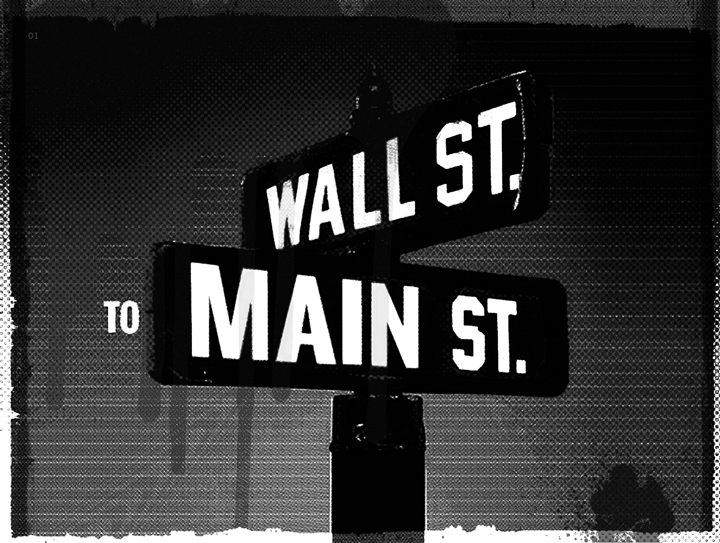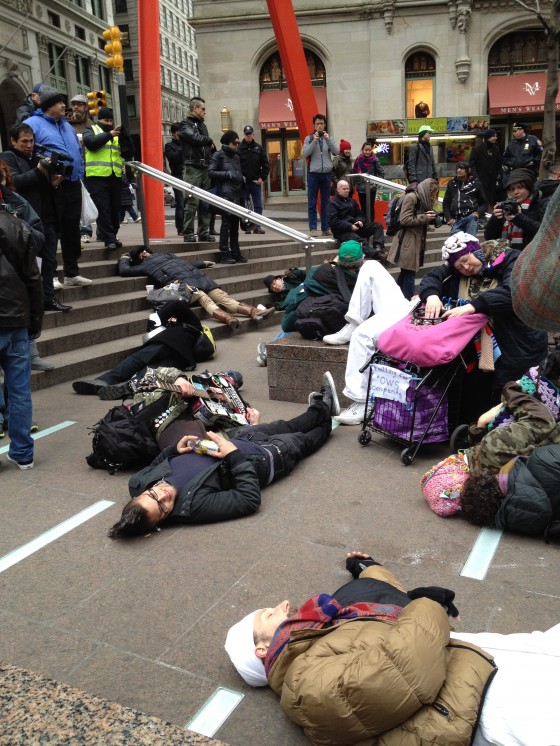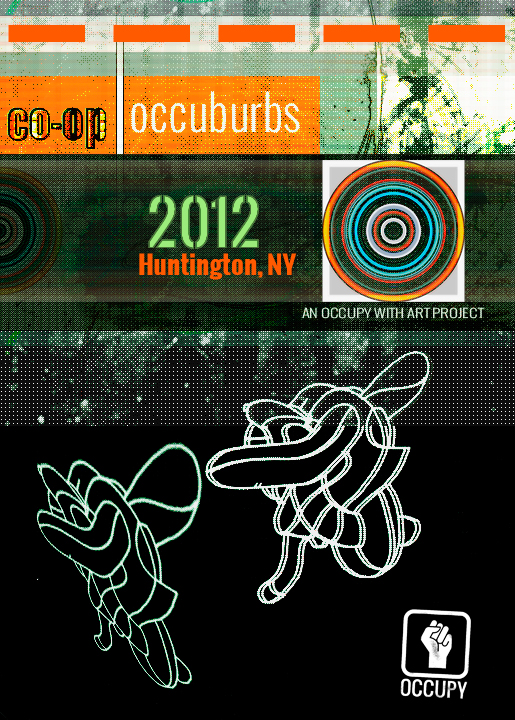Another Dose of "Withering Ridicule" (for Andrew Sorkin)
 Thursday, September 20, 2012 at 12:52AM
Thursday, September 20, 2012 at 12:52AM 
Andrew Sorkin [Photo Credit: (CC) Larry D. Moore]
Another Dose of "Withering Ridicule" (for Andrew Sorkin):
A response to Sorkin's NYT Dealbook post "Occupy Wall Street: A Frenzy That Fizzled"
By Paul McLean
I had gone down to Zuccotti Park to see the activist movement firsthand after getting a call from the chief executive of a major bank last week, before nearly 700 people were arrested over the weekend during a demonstration on the Brooklyn Bridge.
“Is this Occupy Wall Street thing a big deal?” the C.E.O. asked me. I didn’t have an answer. “We’re trying to figure out how much we should be worried about all of this,” he continued, clearly concerned. “Is this going to turn into a personal safety problem?”
- Andrew Sorkin, "On Wall Street, a Protest Matures"
"Fizzle?" "Frenzy?"
One curious effect Occupy Wall Street has on mediocre corporate media writers: OWS seems to induce them to absolve themselves of their consistent incapacity to ever comprehend the movement as such. Andrew Sorkin, who is a New York Times business writer, the inventor of Deal Book, and a gadfly expert for TV talking head shows, is reduced to calling Occupy mean names (a "fad"), critiquing its organizational performance and bragging on behalf of criminal banking syndicates who managed to evade accountability, in spite of OWS protesters. He comes off bitter and confused though.
Sorkin is well-educated. He attended an Ivy League school and stuff. Why is he so dumb about Occupy?
He writes:
By the second or third time I went down to Zuccotti Park, it became clear to me that Occupy Wall Street, which began with a small band of passionate intellectuals, had been hijacked by misfits and vagabonds looking for food and shelter.
Given the way the organization — if it can be called that — was purposely open to taking all comers, the assembly lost its sense of purpose as various intramural squabbles emerged about the group’s end game.
It feels pointless to parse even these two short paragraphs. Occupy Wall Street isn't a boat or plane or car driven by "a small band of passionate intellectuals" that could be hijacked. Don't hijackers make demands? Occupy refused to do that.
"Misfits?" "Vagabonds?" Which Occupy did Sorkin visit once, twice or three times? The one on FOX News? Thank goodness Sorkin didn't find the same terrifying OWS that Michael Gerson of the Washington Post screeched about, which Gerson was able to analyze without even visiting Liberty Square once! Sorkin's befuddled but calm snark wouldn't have survived a minute in Gerson's hellish imaginary Occupy.
There's so much wrong with the couple of sentences quated above. They reveal much more about Sorkin than they do about OWS. "Intramural squabbles?" "End Game?" I keep envisioning Lurch of the TV version of The Adams Family, groaning and shaking his head. Occupy Wall Street never was a collegiate thing, although plenty of college students support it, which is not surprising, given the skyrocketing student debt burdens in this country, and dreadful employment outlook. So where did that "intramural" quip come from? And "End Game" just sounds so Think Tank-y. There is an OWS working group called Think Tank. I don't think that's what Sorkin had in mind. He likely has never heard of Occupy's Think Tank.
Why should we care about Sorkin's opinion or faux analysis, anyway?
Sorkin, according to a report I read, has a net worth in the neighborhood of $10,000,000. By any measurement that situates him in the wealthiest percentile of American citizens. He's a 1%er. Should we expect anything other than what he offers us, which is a perspective that ultimately diminishes the movement opposing his status in society, his class? Sorkin's animus against OWS could be a simple case of self- or class-preservation.
I guess one reason to pay attention to Sorkin is that his is no ordinary opinion, even if it's blogged. It's typical of a blogger to use his own vehicle to record and share his thoughts. This is the basic usage of a web log. Sorkin is a blogger. It just happens to be a fact that his blog is attached to the New York Times, America's most prominent newspaper.
So, to consider the relevance of Sorkin's view of Occupy, we need to note the context. The NY Times is quite an amplifier for opinion, or can be. That the Times reduces coverage of the most recent OWS protests to a couple of minor or perfunctory reports/blurbs in its blogs [plus an opinion piece (also-OWS negating) by Joe Nocera]. one blurb being Sorkin's hit piece (lite), instead of providing a more in-depth reportage of the Occupy anniversary, is only consistent with the editorial policies the newspaper has applied to the OWS story from its beginnings. The New York Times has in effect done its part, as a member in good standing of the corporate media monopoly, to minimize, marginalize and neutralize Occupy Wall Street, since September 17, 2011.
It needs to be said. OWS has been and continues to be without any question a news story of international interest. No matter how much or little the Times' formidable resources might be devoted to covering it.
Sorkin is incorrect in his characterization of corporate media's response to Occupy as a "frenzy," after an initial period of coverage lack. The media, and specifically, the New York Times, through last weekend, has failed to represent the actuality of Occupy as it has unfolded. Numbers of protesters are always underestimated by the Times, for example. Episodes of police brutality against reporters and protesters are rarely explored with any depth at the Times. The civil and legal ramifications of Bloomberg's repression of OWS, the national coordination of occupation evictions, and most importantly, the issues that Occupy has directly confronted are dark matter in the Times' content universe. The NY Times has, if anything and with few exceptions, proved complicit in "managing" the narrative of OWS, which happened, literally, on the paper's doorstep. Sorkin is not exceptional, relative to the Times' crap performance reporting on OWS.
Sorkin's essay is a routine Times-propagated prevarication on OWS, mixing outright falsehoods with half-truths and unsorted non-sequitors. The blogger and media pundit poses rhetorical questions and answers them with talking-points of that prove little more than Sorkin's own biases.
We occupiers shouldn't take it personally, though. Despite the fact that the fanatic "right" media, which is selectively democratic by nature, to put it nicely, and a savage thresher of American values, to put it more realistically, has used the Times as a whipping boy for years. Let's face it. The Times generally is not anything like a "leftist" organ, in any but a few areas of social discourse, and never has been. That said, we can scan the Times' reporting on the many protest movements active around the world over the past year and more, like the one in Greece, or the one in Spain, or the one in Mexico, and so on. When it comes to people resisting top-down oppression, both political and economic, the Times isn't interested. It's more interested in turning Euro negotiations into drama, for example, than expending word count on human cost or resistance. The Times does like the odd action photo of cops in riot gear, though.
The Times is kind of like Mitt Romney. It knows its constituency, and is making itself answerable to only that constituency, and the Times' constituency does not include the sorts of people who would protest in the streets, whatever the grievance. It's a kind of calculus. To quote from O Brother Where Art Thou, the powerful only need ask, "Is you is, or is you ain't, my constituency?" If you ain't, you SOL. OWS, with regards the Times (and Romney, too) is SOL.
It's helpful to get a clear picture of the paper's position on peaceful citizen or "populist" mass resistance to authoritarian systems and regimes, when thinking about Sorkin and his views. Even though the world's most massive assemblies - ever - against programmatic "Austerity" and other anti-democratic or anti-social policies occurred over the past several months, or depending how one scores it, years, stretching the timeframe to include the anti-Bush/anti-Iraq War demonstrations, or even the anti-IMF outbreaks, the Times has never devoted more time, space, resources, reporters to these stories, as it has to say, fashion, movies and books. Or mergers. Or whatever.
Sorkin's not really the big deal here. The Times employs him. The Times gutted its newsroom, and all it has left for analysis of one of the year's major news stories is some snarky brat with a good media appearance portfolio and a book on the 2007 crash that not many outside the corporate media circles in which Sorkin flits considers relevant. Besides, Sorkin has a rep as being overly "cushy" with his subjects. Compare Sorkin to someone like Matt Taibbi for contrast.
The Times, with its totemic heads like Kristof, is more a tool of globalist-extremist Davos, than of any generic-extremist "left." Krugman, of course is the one truth-sayer at the Times I can think of - a shining light. He's the token. Sorkin is just a tool.
Turnabout is fair play, Occupiers, and the only thing to do is write off Sorkin and his harangue. Whatever. His tight-assed screed is only a little more subtle than straight-up propaganda. That's what an Ivy League education and a few years on the corporate media treadmill do for shills. It softens the edges of the push-blade. The good news is that few of the 99% read Sorkin, and fewer every day read the Times.
For what it's worth: Sorkin didn't seem all that impressed with the organizational efficiency of the World Economic Forum, either, but the means test for Davos was "networking." Judging from his January 2011* post, he did seem better able to learn about the details of the astonishing monetary burdens attached to attending the gathering at Davos, than he was at assessing what's been happening with Occupy Wall Street. Maybe Sorkin would get a better handle on OWS, if Occupy were reducible to dollars on an expense account, or something like that. Maybe Sorkin could have taken a step back from his assessments of the fees at the WEF to cross-reference those numbers with expenditures by an average American family of five. That would have been the Occupy thing to do.
I don't know if Sorkin paid his own way to Davos in 2011, or if the Times picked up the tab, but either way, for a guy worth millions, hobnobbing with the 1% seems to have been more rewarding, pleasant and productive than the exchanges he found during a few short (cheap or free) trips from the Times offices to Liberty Square, based on the resulting texts. At least the trip to Switzerland didn't put Sorkin in the same snarky state of mind Occupy did, for some reason. Maybe Sorkin prefers the Alps to the financial district of Lower Manhattan, when the latter's occupied. I can't recall whether Sorkin wrote anything about the occupation of the most recent WEF.
Just for fun, let's juxtapose the two posts, Sorkin's Occupy send-up and the WEF cost-benefit analysis. Or let's frame it as a kind of imagination game, rooted in a conjecture. Is there a difference between WEF and OWS experiences and cost-wise? Did Sorkin note these? Sorkin, during the occupation, could have eaten gratis at the OWS Kitchen, like all the rest of us vagabonds. Or picked out a book to read at the OWS Library. Or joined a teach-in led by one of those passionate intellectuals who shared their ideas and technical know-how with all comers, even misfits. Or offered one: "How to Start a Business Blog at the New York Times." Or Sorkin could have tried to air all his critiques of Occupy at the GA.
I would have liked to have seen that. Did it happen? No. Would it have been neat for Sorkin to compose a structural comparison between the WEF and OWS? You betcha! Did it happen? No.
Really, Sorkin's tally of what Occupy Wall Street didn't accomplish might be boiled down to one thing. Occupy failed to change this pundit's affiliations. He's going to stick with what and who he perceives to be the winners. He's convinced evidently that his estimates of the potential of OWS to alter the topology of civilization as it has been for ages with few sustaining exceptions - an entrenched set of inequities rooted in extraction and exploitation industries and war machines, coupled to corrupt politicians, protected by militarized police forces, surveillance apparatuses, prison systems and message managers - are correct, and that Occupy ought to be graded poorly on that basis. Sorkin is tied to the money, and time, in the Sorkinian corporato-media-matrix, is money, and so is free speech, and the ultimate bottom line.
Time will tell whether Sorkin has chosen wisely. For now, to shift the discussion out of the realm of fairness, or honesty or truth in reporting and/or opinionating, to the realm of spirit, as citizen practicum. Perhaps all Sorkin's gambling with is his democratic soul. Maybe the crux is not his professional credibility. I know, this is the stuff of insoluble speculation.
Still, I'm cleaving to the Arendt model, and not the Blankfein or Dimon one. Sorkin opens "A Hefty Price for Entry to Davos" with this line: "What’s the price tag to be a Davos Man?" The question is whether the answer is a dollar figure, or a spiritual, or at least moral, choice. Blankfein, whom Sorkin once called "the man who can do no wrong," and Dimon, are both Davos men. Maybe we could ask them. Maybe one of them was the sphincter-clinching banker who called Sorkin to get the reporter off his ass, out of the office, and down to Zuccotti Park (see Sorkin's first Occupy essay**, quoted above).
Instead of waiting for a 1%er to phone him to get his expert take on the threat level posed by Occupy (the impetus for Sorkin's first OWS story) to the super-rich, maybe Sorkin will pause to consult his conscience, first. Do I believe that will happen? No. Is it any of my business? Not really. In times like these, maybe all the time, what a person decides to do when faced with pervasive evil, which is what is now the status quo on Wall Street, is his own affair, ultimately.
But, with regards Occupy's impact on the national political scene, all concerns about Sorkin's soul aside... Ask yourself one question: Would Mitt Romney, the ALEC, US Chamber of Commerce, AEI, Koch brother candidate of choice, be on the skids in this election season, if it weren't for OWS? Would Andrew Sorkin and Joe Nocera [or any other pundit] be questioning Romney's serial tax evasion, or his history as on-again/off-again Bain CEO, or his disdain for 47% of Americans? The true answer is NO. Go Occupy! Happy birthday!
* http://dealbook.nytimes.com/2011/01/24/a-hefty-price-for-entry-to-davos/
** http://dealbook.nytimes.com/2011/10/03/on-wall-street-a-protest-matures
Post-script: Here's a little more background on Sorkin and OWS, courtesy Think Progress (http://thinkprogress.org/media/2011/10/01/333749/andrew-ross-sorkin-sneers-occupy-wall-street/)
And a great piece on the Times' coverage of the OWS anniversary here at FAIR (Fairness & Accuracy in Reporting): http://www.fair.org/blog/2012/09/18/nyt-buries-occupy-wall-street/
 admin |
admin |  Post a Comment |
Post a Comment |  Paul McLean,
Paul McLean,  essay in
essay in  texts
texts 

















![PRESS RELEASE FOR IMMEDIATE RELEASE The Arts & Culture Space Team will be occupying the offices of Hyperallergic from February 1 through the end of March 2012. On Sunday, February 5 at 7PM, the Spatial Occupation Reading Group will convene with an orientation session. [PROPOSITION 1]: At our first meeting, we will ask ourselves to construct a reading program for the two-month residency at Hyperallergic. What are the questions we would like to raise? What texts and printed matter will be in our library that speak to those questions? Our initial focus - aligned with the residency objectives - will be Occupied Space, and the projection of it, its materialization processes, the definitions and realities of space and habitation. How does history affect (or not affect) space, or location? Time? Naming? Do the differences between virtual and actual need to be addressed, or can they co-exist? Who owns “space,” and who owns “occupation” of it? What contingent schemes emerge, once we begin to answer such questions. Is space a fact? Can or does space change? Is occupation the energy that drives such change, and is such change progressive or systematic? Of course, because we are agents of Arts & Culture, these and other considerations and conjectures will be inspected through that particular lens, at least to begin. Because we are OWS, we must articulate our grievances (peacefully), for their redress; & because we are OWS, we must simultaneously investigate ourselves, collectively, individually, expressively. Finally, we can explore what arts best apply to space and occupation, and who and what factors engage to determine the spatial arts of Occupy, in this threshold moment - [an event?]. The “Spatial Occupation” residency at Hyperallergic will generate screenings, a reading group, exhibits, performances, demonstrations, artist talks, workshops, teach-ins and much more over a two-month span. To learn more about the residency, visit the website ( http://spatial-occupation.tumblr.com/ ) or contact the Space Team ( ows-arts-and-culture-spaces@googlegroups.com ). About Hyperallergic: Hyperallergic is a forum for serious, playful and radical thinking about art in the world today. To learn more, visit the website ( http://hyperallergic.com/about/ ) Hyperallergic: 181 N 11th St Brooklyn, NY 11211 Spatial Occupation Reading Group Session 1 [Orientation]: 7PM, Sunday February 5, 2012 ###](http://24.media.tumblr.com/tumblr_lypz2486Qf1roqpujo1_500.jpg)








